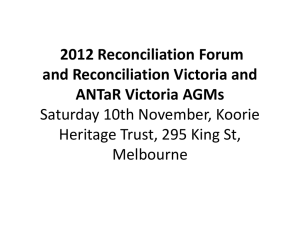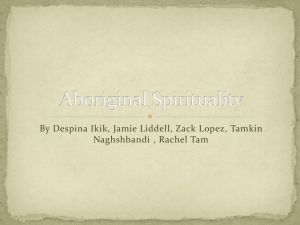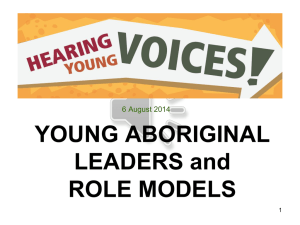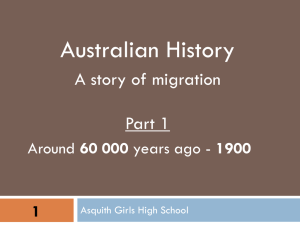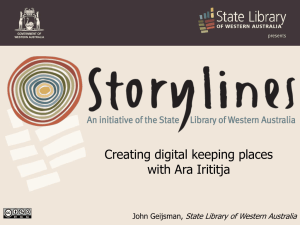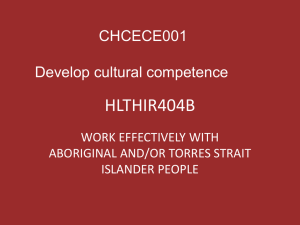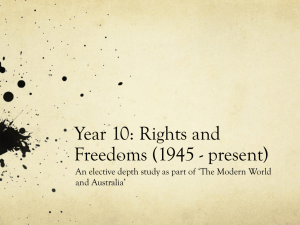Dots 1 2 3 4 9
advertisement
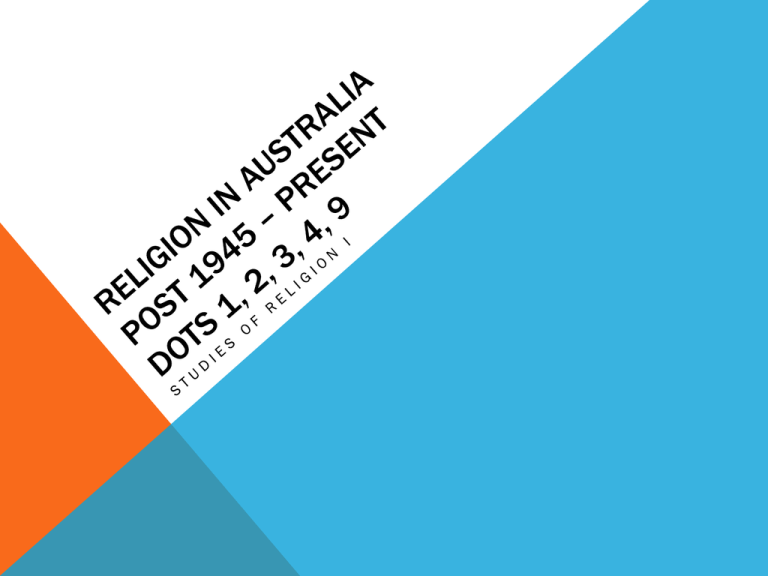
Identify issues and provide points for and/or against Identify issues and provide points for and/or against General terms; indicate the main features of Identify components and the relationship between them; draw out and relate implications Inquire into TRIAL QUESTIONS 2. Which statement best expresses the Native Title Act 1993? a. Legislation which provided Aboriginal people with the right to continue to observe their traditional laws and customs. b. Legislation which changed the way Australian law views the relationship of Aboriginal People to the Land. c. Legislation which enabled the States and Territories to curtail the right of Aboriginal people to negotiate. d. Legislation which recognised the existence of Aboriginal native title in Australian federal law. 5. The Land Rights Movement is an essential issue for Aboriginal Peoples because? a. Land is at the heart of the Dreaming. b. Land is at the heart of the political movement. c. Their religious and cultural integrity is preserved. d. Their relationships within Aboriginal communities are determined through relationship to the land. 6. The title of the book by Dr Anne Sarzin and Lisa Sarzin: ‘Hand in Hand” Jewish and Indigenous people working together’, is and example of” a. Resolution b. Reconciliation c. Reconstruction d. Reconfiguration TRIAL QUESTIONS 9. Which aspect of Aboriginal culture or Spirituality is illustrated by the image above? a. Ceremonial Life b. Dreaming c. Kinship d. Obligation to Land 10. For members of the relevant Aboriginal language speaking group, this diagram depicts? a. The system of the expression of Dreaming in a physical sense. b. The system of key persons and keepers of various knowledge within Aboriginal communities. c. The system of key obligations of each group to care for children of other skin groups. d. The system of relationships traditionally accepted by particular culture and the rights and obligation they involve. DOT 1 - DISCUSS HOW ABORIGINAL SPIRITUALITY IS DETERMINED BY THE DREAMING Dreaming is the foundation of Aboriginal spirituality • Relationship with ancestral beings • Dreaming includes all knowledge • Contains beliefs and practices • Origins of the universe • Dreaming is inextricably connected to the land • Dreaming is a metatemporal • The process of telling and learning the stories of the Dreaming is a life long DOT 1 - DISCUSS HOW ABORIGINAL SPIRITUALITY IS DETERMINED BY THE DREAMING Kinship is the fabric that binds the Dreaming together • Belonging • responsibilities within a clan • totem • govern the day to day life • transmit the knowledge of the Dreaming from elders to the younger generation Relationship with the Dreaming: • Kinship groups established by ancestor beings in dreamtime, along with other laws • It is the tangible expression of Dreaming in everyday life. • The way the individual experiences the Dreaming (ceremonies, sacred sites etc.) is entirely determined by the connection of the kinship group. • Roles, rights, responsibilities of kinship group are defined and explained through Dreaming stories. DOT 1 - DISCUSS HOW ABORIGINAL SPIRITUALITY IS DETERMINED BY THE DREAMING Land underpins the reality • Dreaming is inextricably connected to the land • Land as mother • “My Country” • Land is the physical medium through which the Dreaming is lived and communicated • dwelling place for ancestral spirit beings • Acknowledge traditional owners • Beliefs, traditions, rituals and law through the dreaming are embedded in the land • Sacred sites connected to dreaming events • Ritual responsibilities include balance rites Reflected in the Dreaming: • Land holds sacred places for all people. • Land is context of dreaming, inhabited by the ancestor spirits whom the people maintain a strong link with. • Responsibility to land physically and tangibly derives from and preserves the Dreaming as living religion. DOT 1 - DISCUSS HOW ABORIGINAL SPIRITUALITY IS DETERMINED BY THE DREAMING Ceremonial Life - The complex and spiritual core of the Dreaming and Dreaming stories for each group is recognised and revered in ceremonial life, encompassing performance of rituals at sacred sites, the drawing of sacred symbols and corroborees • Art communicates the dreaming because it illustrates the actions of the ancestral beings • Stories explain right and wrong (tradition and law) and it is a socialisation tool • Rituals are a metatemporal tool not just retelling the story; eg smoking ceremony • Totems link the individual or community to the Ancestral spirits in the land and have ceremonial responsibilities. Reflected in the Dreaming: • Ceremonial life acknowledges the Dreaming as a fundamental aspect of human life while practice sustains it as a vital part of spirituality. • Ceremonies commonly pertain to sacred sites where, as revealed in the Dreaming, ancestor beings are said to inhabit. • Burial rites acknowledge the intrinsic spiritual link of the individual with the life DOT 2 - DISCUSS THE CONTINUING EFFECT OF DISPOSSESSION ON ABORIGINAL SPIRITUALITIES IN RELATION TO: SEPARATION FROM LAND; SEPARATION FROM KINSHIP GROUPS; THE STOLEN GENERATION • The impact of dispossession for Aboriginal people has been enormous and overwhelmingly detrimental. Broadly speaking, the history of dispossession can be divided into three key stages. • Firstly, the colonial period of non-recognition, which were marked by the introduction of terminal European diseases, shootings, massacres and poisonings. • This was then followed by the paternalistic policy of protection, which began in the mid 1880s. • This was followed by the equally detrimental policy of assimilation, which began in the mid-twentieth century. As a part of and spanning across the official Government policies of protection and assimilation, are the dark episodes of the Stolen Generation. DOT 2 - DISCUSS THE CONTINUING EFFECT OF DISPOSSESSION ON ABORIGINAL SPIRITUALITIES IN RELATION TO: SEPARATION FROM LAND; SEPARATION FROM KINSHIP GROUPS; THE STOLEN GENERATION • Interfered with rituals and ceremonies which followed Dreaming tracks (paths that follow the Spirit Ancestors as they created the landscape) that provided the people with a physical connection to the Dreaming. • The land is the context of the Dreaming stories, a constant around which their spiritual world revolved. • Loss of identity, since the Dreaming, which is central to Aboriginal spirituality, is inextricably connected to the land. • The loss of land as a result of dispossession leads to the ever-present burden of not being able to fulfil ritual responsibilities. • Removal from this land would then be likely to cause a severe disruption to the normal pattern and processes for handling traditions • Physical presence in the country was important to the people in keeping the lore (stories, songs, dances, art, customs) alive and passing it on. DOT 2 - DISCUSS THE CONTINUING EFFECT OF DISPOSSESSION ON ABORIGINAL SPIRITUALITIES IN RELATION TO: SEPARATION FROM LAND; SEPARATION FROM KINSHIP GROUPS; THE STOLEN GENERATION Separation from kinship groups: • Kinship groups are vital in the aboriginal culture in that they tie clans and families together, allocating roles and responsibilities within a community. • Separation from kinship groups, working systems, then meant that the aboriginal society lost its point of fixture and every personal affiliation became lamed. • The complex interrelationship of social status, personal identity and health must be borne constantly in mind. When the kinship system is destroyed it members inevitably suffer from psychological distress such as withdrawal and depression where the individual has suffered a loss of identify this extends to the breaking up of communities and a spirit of solidarity. • Some missions ban culture, ceremonies are banned, and kin cannot visit. • Virtual destruction of kinship groups undermines basis of culture. • Without numbers to remain self-sufficient and sustain religious and cultural practices, identity suffers. 1930s : Assimilation - forced removal (stolen generations) 1965 : integration. Present : Self-determination. DOT 2 - DISCUSS THE CONTINUING EFFECT OF DISPOSSESSION ON ABORIGINAL SPIRITUALITIES IN RELATION TO: SEPARATION FROM LAND; SEPARATION FROM KINSHIP GROUPS; THE STOLEN GENERATION The Stolen Generation: Aboriginal children were forcibly removed from homes by government officials to be placed in missions or reserves such as the Cootamundra Girls’ Home between the 1900 and 1970’s as well as being adopted or fostered into white families if the children were ‘half caste’. Separation from elders: no generation to pass knowledge, language and traditions to. This results in a loss of identity and self esteem the Aboriginal culture deteriorated Kinship ties were broken resulting in a loss of identity where the young indigenous generation is lost in-between two opposing cultures in a struggle to find balance (see above) Protection Policy: Removal of Aboriginal children from their families under the pretence that they were living in an ‘uncivilised’ environment followed by placement into missions and reserves DOT 2 - DISCUSS THE CONTINUING EFFECT OF DISPOSSESSION ON ABORIGINAL SPIRITUALITIES IN RELATION TO: SEPARATION FROM LAND; SEPARATION FROM KINSHIP GROUPS; THE STOLEN GENERATION Assimilation Policy: 1951: Forced integration of Aboriginal peoples into white society through abandonment of their traditional beliefs and practices. • Forced separation of indigenous children from their families in every state from late 1800s. • During 1950-1970 as many as 100 000 are separated. • 3 forms: government or church run institutions, adoption into white families, fostering into white families. • Separation from family and traditional background resulted in lost identity, culture, language, spirituality and self-esteem. • The National Inquiry into the Separation of Aboriginal and Torres Strait Islander Children from their Families began August 1995 by HREOC. Effects of Stolen Generations and Dispossession: • Loss of economic independence • Loss of identity which is linked intrinsically to the land and kinship groups, unable to perform rites • Isolation from tangible link to spiritual world disables ceremonies, totems, sacred sites etc. • Breakup of family ties results in no continuation of information through generations • Disruption of traditional roles and responsibilities. DOT 3 - OUTLINE THE IMPORTANCE OF THE FOLLOWING FOR THE LAND RIGHTS MOVEMENT: NATIVE TITLE; MABO; WIK Native Title is the communal or individual rights or interests of Aboriginals in relation to traditional land and water 1993 Native Title Act recognizes native title and rights in federal law Gave Indigenous right to posses, occupy, use, and enjoy land so land has had a continuous connection with indigenous people Limited success: Pastoral leases and freehold land where sacred sites were located unable to perform rituals Some people did gain social and economic independence to preserve culture. DOT 3 - OUTLINE THE IMPORTANCE OF THE FOLLOWING FOR THE LAND RIGHTS MOVEMENT: NATIVE TITLE; MABO; WIK June (1992), High Court of Australia ruled in favour of Eddie Mabo: Aboriginal and Torres Strait Islanders had a continuous link with the land and continued to practice laws and customs associated with the land before British colonization. Overthrew the legal fiction terra nullius, acknowledging that Australia was occupied by Aboriginal people in 1788 when British settlement took place. Claimed ownership of land under the ‘Native Title Act’ which existed since 1788, Mabo raised awareness of its existence and this was a step to the passing of the Native Title Act 1993 DOT 3 - OUTLINE THE IMPORTANCE OF THE FOLLOWING FOR THE LAND RIGHTS MOVEMENT: NATIVE TITLE; MABO; WIK The Wik case concerned land that was subject to pastoral leases. (1996) The High Court of Australia decided that native title rights could co-exist with the rights of pastoralists. But when pastoralists and Aboriginal rights were in conflict, the pastoralists’ rights would prevail. The High Court also decided that in areas of dispute where the rights of the leasehold titleholder cannot be reconciled with the native titleholder, the interests of the leasehold titleholder would override the rights of native title holders In 1998 the Howard Liberal Government introduced legislation, which amended the Native Title Act in favour of the leasehold title holder, in response to pressure from rural investors who wanted to reduce the potential rights of native title claimants. This Native Title Amendment Act is commonly referred to as the Ten Point Plan. DOT 4 - ANALYSE THE IMPORTANCE OF THE DREAMING FOR THE LAND RIGHTS MOVEMENT Land is at the heart of the Dreaming and all relationships within Aboriginal communities are determined through relationships with the land. The declaration of terra nullius made by the white settlers denied foundational principles of the Aboriginal belief systems Aboriginal spirituality is founded on the people’s inextricable connection to the land. They are part of the land and the land is part of their being Daily life, Rituals and Ceremonies reflect and revolve around the land and are dependent upon it to be whole, without it these practices cannot be observed DOT 4 - ANALYSE THE IMPORTANCE OF THE DREAMING FOR THE LAND RIGHTS MOVEMENT The Land Rights Movement and the Dreaming: A series of government decisions in response to land claims which explored the right of Aboriginal peoples who had maintained continual contact with their traditional lands for hundreds of years before settlement Both a religious and political movement Aimed to secure the inherent rights of Aboriginal peoples to their land so that their religious and cultural integrity is preserved. DOT 4 - ANALYSE THE IMPORTANCE OF THE DREAMING FOR THE LAND RIGHTS MOVEMENT Post WWII resulted in a change of attitude toward colonialism and assimilation. 1972: self-determination becomes policy in all indigenous affairs. 1960s sees Indigenous people pursue justice and establish themselves as part of political landscape. 1965: Charles Perkins takes bus tour of students to northwest NSW to protest racial discrimination; The Freedom Riders. (reinactment 2011) Generates national attention on racism cemented by White Australia Policy. Denied service in shops, separated in cinemas, excluded from bars and swimming pools used by whites. Australian Day 1972: the Aboriginal Tent Embassy on Parliament House Lawn became a focal point for protests against denial of rights, conditions, and lack of govt. action. Ignited by 1963 presentation of bark petition to commonwealth govt. from Yirrkala people. 1966: Gurindji people strike for claim on Wave Hill station in NT. DOT 9 – EXAMINE THE RELATIONSHIP BETWEEN ABORIGINAL SPIRITUALITIES AND RELIGIOUS TRADITIONS IN THE PROCESS OF RECONCILIATION Christian groups are a part of the reconciliation movement and in support of issues such as land rights, native title and a formal apology to the Stolen Generation and were one of the first advocates of Aboriginal rights. • In 1967 the Catholic Church and representatives of the Australian Council of Churches were among the most prominent leaders of the campaign for the referendum to grant Aboriginal Australians citizenship. • In 1975 various church groups supported and applauded the passing of the first land rights legislation by the Whitlam Government. • In 1992 the Mabo decision was publicly welcomed by many church groups. When conservative political factions and various media groups began a fear campaign, churches made strong statements affirming that the Mabo decision was just. • In 1998 churches adamantly opposed the Ten Point Plan, which they saw as a severe and unjust reduction on the rights of Aboriginal people to make native title claims. DOT 9 – EXAMINE THE RELATIONSHIP BETWEEN ABORIGINAL SPIRITUALITIES AND RELIGIOUS TRADITIONS IN THE PROCESS OF RECONCILIATION • ANTaR (Australians for Native Title and Reconciliation) is a church supported community based organisation advocating indigenous rights and organised the Sea of Hands display promoting reconciliation and justice. • 1997 following the publication of the Human Rights and Equal Opportunities Commission's (HREOC) report Bringing Them Home church groups offered formal apologies regarding the role of missionaries in the abuse of Aboriginal people. • Jewish groups for example hold a week of prayer for reconciliation every year. • In 1998 the Australian and New Zealand Union for Progressive Judaism voiced their support for the Wik decision and opposed the Ten Point Plan. • In 2000 the Executive Council of the Australian Jewry also urged the Australian Government to implement the recommendations made by the National Inquiry into the Separation of Aboriginal and Torres Strait Islander Children and Their Families. • The Australian Federation of Islamic Councils and the Buddhist Peace Fellowship have also made statements in support of indigenous rights and reconciliation. DOT 9 – EXAMINE THE RELATIONSHIP BETWEEN ABORIGINAL SPIRITUALITIES AND RELIGIOUS TRADITIONS IN THE PROCESS OF RECONCILIATION • The Rona-Tranby project, which recorded oral history with the help of Aboriginal Elder Eliza Kennedy of the Nglyampaam people (western NSW), was funded by money left by a Jewish couple, Tom and Eva Rona. • The Uniting Church and the Aboriginal and Torres Starit Islander Christian Congress organized for about 150 non-indigenous people aged between 18 and 30 to live in ATSI communities in an exchange program called “About Face”. Participants described it as ‘life-changing’ and ‘profound’. • We welcome this initiative and hope it [the Uniting Church ‘About Face’ exchange program] will have results, changing dramatically for better the lives of indigenous people who have suffered alienation and dispossession in their own land for far too long. Australian Catholic Bishops Conference • The Muslim community in Australia is most supportive of Aboriginal reconciliation on spiritual, moral, humanitarian and prudential pragmatic grounds. Dr MA El Erian, Emeritus Professor, past president Islamic Society of Australia. • I believe that we will only know who we are, and build on a firm foundation, when we have grieved our past and made a peace with Aboriginal people. When we do this, the celebration of life here can authentically begin. Rev. Dorothy Rae-McMahon, Uniting Church. DOT 9 – EXAMINE THE RELATIONSHIP BETWEEN ABORIGINAL SPIRITUALITIES AND RELIGIOUS TRADITIONS IN THE PROCESS OF RECONCILIATION • Pope John Paul II visited Alice Springs in 1986, he stated ‘there is the need for just and proper settlement that lies unachieved in Australia’ • 1998, joined with other churches to issue a statement called ‘Towards Reconciliation in Australian Society- Reconciliation and Aboriginal Australians’ which argued for the settlement of differences between ATSI and non-ATSI people • CARITAS Australia has called for more assistance to ATSI due to the ongoing psychological trauma of the Protection and Assimilation Policies • Catholic Bishops Conference Australia established a commission concerned with relations between the church and Aboriginal Communities • National Reconciliation Week sees a week of Catholic Initiatives promoting reconciliation particularly regarding Aboriginal health • Pope Benedict’s recent address to Australia, encouraging ongoing help for ATSI people DOT 9 – EXAMINE THE RELATIONSHIP BETWEEN ABORIGINAL SPIRITUALITIES AND RELIGIOUS TRADITIONS IN THE PROCESS OF RECONCILIATION • Anglican Church funded the National Aboriginal and Torres Straight Islander Ecumenical Commission (NATSIEC), giving a voice to ATSI people and helping rebuild ATSI communities • Anglicare Australia and the Anglican Board of Missionaries formed the Anglican Reconciliation Working Group which provides accommodation, health care, family support for ATSI communities • Anglican Church return of land to local ATSI communities at a diocesan level • Uniting Aboriginal and Islander Christian Congress, Townsville works with ATSI people to promote healing and reparation of past wrongs • Uniting Church National Assembly made formal apology to ATSI people • NCCA issued a public statement on the ‘Bringing Them Home’ report making recommendations in support of Reconciliation DOT 9 – EXAMINE THE RELATIONSHIP BETWEEN ABORIGINAL SPIRITUALITIES AND RELIGIOUS TRADITIONS IN THE PROCESS OF RECONCILIATION Many Aboriginal clergy incorporate Indigenous symbols and rituals from their own culture to express Christian concepts Use Indigenous coconut milk instead of wine and damper or yam instead of bread Christian stories often retold with an Indigenous slant (instead of fire, they talk about fire sticks) Red ochre used instead of ashes/oil on forehead Prayers able to be told in Indigenous languages

